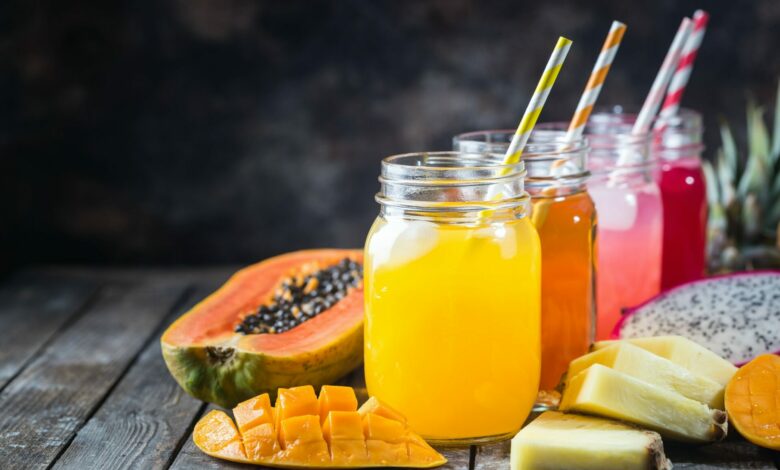
In the quest for optimal health and well-being, the world is increasingly turning towards natural remedies, and among them, healing juices have emerged as a powerful force. Packed with essential nutrients, antioxidants, and healing properties, these juices have gained popularity for their potential to promote physical, mental, and emotional well-being. In this comprehensive article, we will delve into the top 10 healing juices of 2024, decoding their benefits and exploring the science behind their healing prowess.
Sugarcane Juice

Sugarcane juice, extracted from the tall, slender stalks of the sugarcane plant, has been cherished for centuries not only for its sweet taste but also for its numerous health benefits. This natural elixir, commonly consumed in tropical regions, is not just a refreshing beverage but a powerhouse of nutrients that contribute to overall well-being.
Nutritional Profile:
Sugarcane juice is a rich source of essential nutrients, including carbohydrates, proteins, and minerals. It is low in cholesterol and saturated fats, making it a healthy alternative to artificially sweetened beverages. The juice is also abundant in vitamins such as A, C, B1, B2, B3, B5, and B6, along with vital minerals like calcium, potassium, magnesium, and iron.
Hydration and Detoxification:
One of the primary benefits of sugarcane juice is its ability to keep the body hydrated. The high water content in the juice helps in maintaining optimal fluid balance, especially during hot weather or after strenuous physical activity. Additionally, sugarcane juice acts as a natural detoxifier, flushing out toxins from the body and promoting kidney function. The presence of antioxidants further aids in neutralizing harmful free radicals.
Boosts Energy Levels:
The natural sugars present in sugarcane juice, primarily sucrose, fructose, and glucose, provide a quick and sustainable energy boost. This makes it an excellent choice for athletes or individuals engaging in intense physical activities. The juice serves as a natural source of carbohydrates, replenishing glycogen stores and preventing fatigue.
Regulates Digestion:
Sugarcane juice is known for its digestive properties. It contains fiber, which aids in maintaining a healthy digestive system by preventing constipation and promoting regular bowel movements. Additionally, the alkaline nature of sugarcane juice helps in maintaining the acid-base balance in the stomach, reducing the risk of digestive disorders.
Supports Immune Function:
The abundance of vitamins, particularly vitamin C, in sugarcane juice contributes to a robust immune system. Vitamin C is known for its antioxidant properties, which protect the body against infections and illnesses. Regular consumption of sugarcane juice may help strengthen the immune system and enhance the body’s ability to fight off common ailments.
Skin Health Benefits:
The vitamins and antioxidants present in sugarcane juice play a crucial role in promoting healthy skin. Vitamin C, in particular, stimulates collagen production, improving skin elasticity and reducing the signs of aging. The juice’s hydrating properties also contribute to a radiant complexion, making it a natural beauty elixir.
Weight Management:
Contrary to popular belief, moderate consumption of sugarcane juice can be part of a healthy diet. The natural sugars in the juice are easily digestible, providing a quick energy boost without contributing to excessive calorie intake. When consumed in moderation, sugarcane juice can be a satisfying and guilt-free alternative to sugary sodas and artificially sweetened beverages.
Sugarcane Juice Recipe
- Ingredients:
Fresh sugarcane stalks
Water
Ice cubes (optional)
Lemon juice (optional)
Equipment:
Sugarcane juicer or a strong blender
Cheesecloth or fine sieve
Glasses
- Instructions:
- Selecting and Preparing Sugarcane: Choose fresh and firm sugarcane stalks. Look for ones with no signs of molds or damage. Peel the outer layer of the sugarcane using a knife, exposing the juicy interior.
- Cutting the Sugarcane: Cut the sugarcane into smaller, manageable pieces. Aim for pieces that can easily fit into your juicer or blender.
- Juicing with a Juicer: If you have a sugarcane juicer, feed the sugarcane pieces through the machine. Collect the juice in a bowl or jug.
- Blending Method: If you don’t have a sugarcane juicer, you can use a blender. Cut the sugarcane into smaller chunks and blend with water until you get a smooth mixture.
- Straining: Place a fine sieve or cheesecloth over a clean bowl or jug. Pour the blended sugarcane mixture through the sieve, extracting the juice while leaving behind the fibrous pulp.
- Extracting Maximum Juice: After straining, gather the leftover pulp in the cheesecloth or sieve and squeeze to extract any remaining juice.
- Adjusting Sweetness and Flavour: Taste the sugarcane juice and adjust the sweetness by adding more water if needed. Some people like to add a dash of lemon juice for a hint of citrusy flavour.
- Chilling: Refrigerate the sugarcane juice for a couple of hours or serve it over ice cubes for a refreshing, cool drink.
- Optional Additions: Customize your sugarcane juice by adding mint leaves, ginger, or a pinch of salt for added flavour.
- Serving: Pour the chilled sugarcane juice into glasses and serve immediately.
Amla Juice – The Healing Juice of All Times
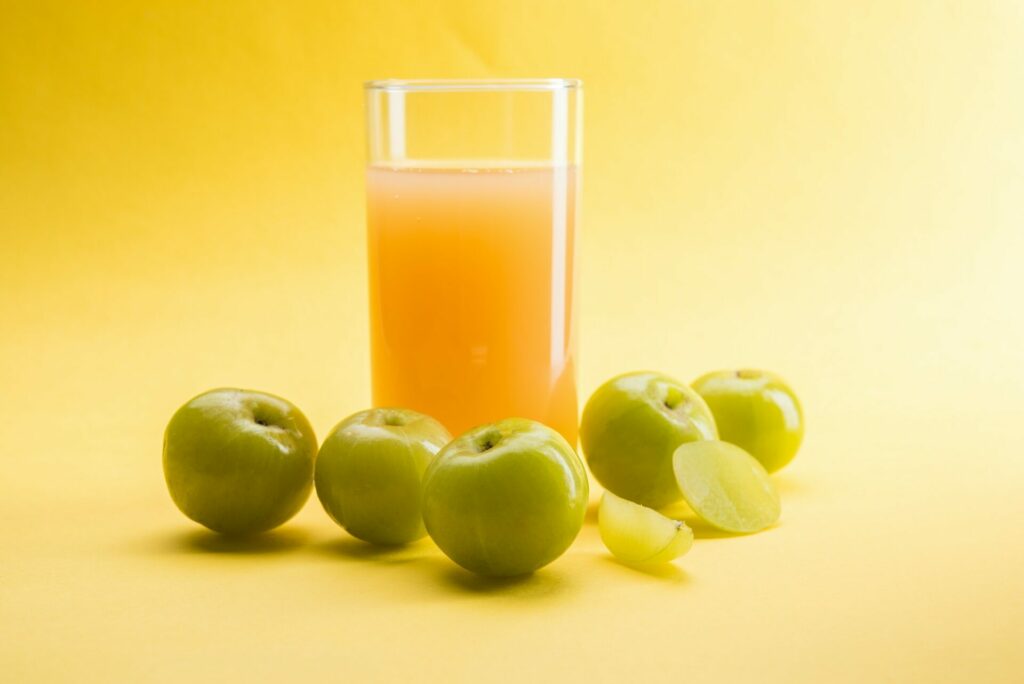
Amla, scientifically known as Phyllanthus emblica, has been revered in traditional Ayurvedic medicine for centuries. Commonly referred to as Indian gooseberry, this small, green fruit packs a nutritional punch that has made it a staple in holistic wellness practices. One of the most popular ways to harness its benefits is through the consumption of Amla juice.
Nutrient-Rich Composition
Amla is a powerhouse of essential nutrients, including vitamin C, antioxidants, polyphenols, and minerals like calcium and phosphorus. The concentration of vitamin C in Amla surpasses that of many citrus fruits, making it a potent immune booster. Antioxidants in Amla, such as polyphenols and flavonoids, combat oxidative stress and neutralize free radicals, contributing to overall health and longevity.
Boosting Immunity
The high vitamin C content in Amla juice plays a pivotal role in strengthening the immune system. A robust immune system is crucial for warding off infections, allergies, and illnesses. Regular consumption of Amla juice can contribute to the body’s defence mechanism, enhancing its ability to fight off pathogens and promoting general well-being.
Digestive Health
Amla juice is known for its positive impact on digestive health. It acts as a natural detoxifier, aiding in the removal of toxins from the body. The fibre content in Amla promotes regular bowel movements, preventing constipation and promoting a healthy digestive system. Additionally, Amla juice has been shown to stimulate the secretion of gastric juices, facilitating efficient digestion and nutrient absorption.
Hair and Skin Benefits
Amla juice is a well-known elixir for hair and skin health. The antioxidants present in Amla combat free radicals that contribute to premature aging. Regular consumption of Amla juice can promote collagen production, improving skin elasticity and reducing the appearance of wrinkles. When applied topically, Amla juice can also nourish the scalp, strengthen hair follicles, and promote healthy hair growth.
Diabetes Management
Research suggests that Amla may play a role in managing diabetes. The polyphenols in Amla have been shown to have hypoglycaemic effects, helping regulate blood sugar levels. Including Amla juice in the diet may contribute to better glycaemic control, making it a potentially valuable addition for individuals with diabetes.
Heart Health
The antioxidants and anti-inflammatory properties of Amla juice contribute to cardiovascular health. It helps lower cholesterol levels, reduce blood pressure, and prevent the build-up of plaque in arteries. Regular consumption of Amla juice may contribute to a healthier heart and a reduced risk of cardiovascular diseases.
Weight Management
Amla juice can be a valuable companion for those on a weight loss journey. The fibre content promotes a feeling of fullness, reducing overall calorie intake. The antioxidants in Amla may also boost metabolism, aiding in the breakdown of fats and contributing to weight management.
Amla Juice recipe
- Ingredients:
6-8 fresh Amla (Indian gooseberries)
1 cup water
2-3 tablespoons honey or jaggery (optional, for sweetness)
A pinch of black salt or regular salt (optional)
Mint leaves or ginger slices for added flavor (optional)
- Instructions:
- Wash the Amla: Rinse the Amla thoroughly under running water to remove any dirt or impurities.
- Prepare Amla: Cut the Amla into small pieces, removing the seeds. If you prefer, you can also deseed the Amla before cutting.
- Blend Amla: In a blender, combine the Amla pieces with 1 cup of water. Blend until you get a smooth consistency.
- Strain the Juice: Use a fine sieve or cheesecloth to strain the blended Amla mixture. This will help separate the juice from any remaining pulp or fibers.
- Add Sweetener (Optional): If you prefer a sweeter taste, add honey or jaggery to the strained Amla juice. Adjust the sweetness according to your preference.
- Add Salt and Flavor (Optional): For an extra kick, you can add a pinch of black salt or regular salt to enhance the flavor. You may also include mint leaves or ginger slices for added freshness and taste.
- Mix Well: Stir the mixture well to ensure that the sweetener and any additional ingredients are evenly distributed in the Amla juice.
- Serve Chilled: Refrigerate the Amla juice for a few hours before serving. Serving it chilled enhances the refreshing taste.
- Enjoy: Pour the chilled Amla juice into glasses and enjoy its invigorating taste and health benefits.
Aloe Vera Healthy Juice
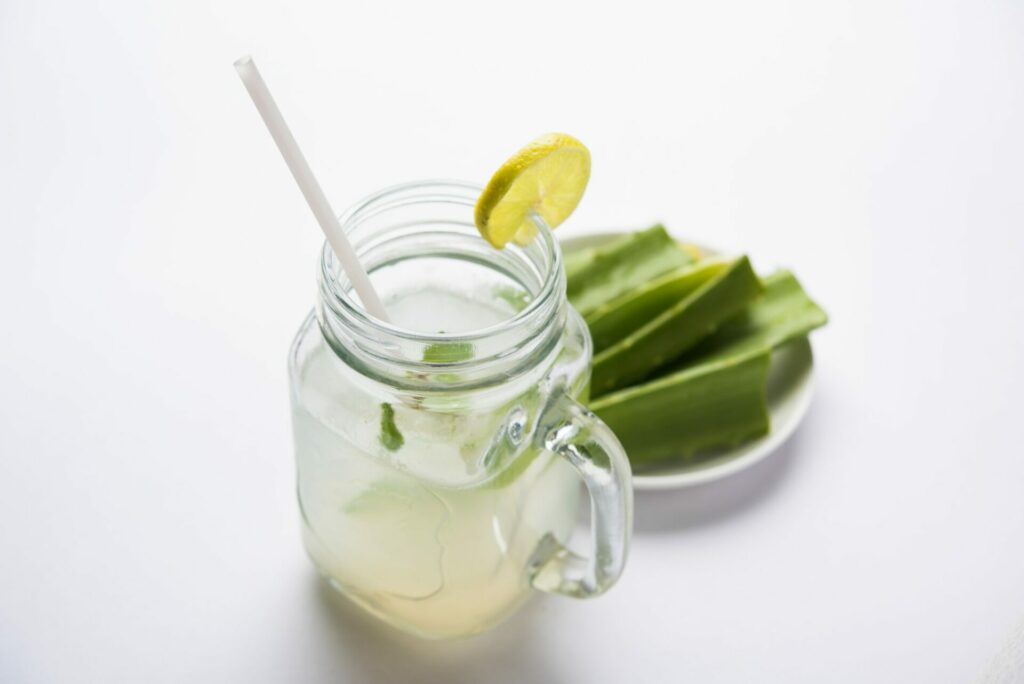
Aloe vera, often referred to as the “plant of immortality,” has been treasured for its medicinal properties for centuries. Among the various forms in which aloe vera is consumed, aloe vera juice stands out as a popular and potent elixir. Packed with a myriad of health benefits, aloe vera juice has become a staple in the wellness routines of many.
Nutritional Composition
Aloe vera juice is derived from the succulent leaves of the aloe vera plant, known for its thick, gel-like substance. Rich in vitamins, minerals, and antioxidants, aloe vera juice boasts a nutritional profile that contributes to its healing properties. It is a good source of vitamins A, C, and E, essential for skin health and immunity. Additionally, aloe vera juice contains B vitamins, including B12, folic acid, and choline, promoting cellular function and energy production.
Digestive Health
One of the primary benefits of aloe vera juice lies in its ability to support digestive health. The juice has natural detoxifying properties that help cleanse the digestive system and promote regular bowel movements. Aloe vera juice can be effective in alleviating symptoms of indigestion, bloating, and irritable bowel syndrome (IBS). The soothing and anti-inflammatory properties of aloe vera can also provide relief to individuals with acid reflux and heartburn.
Immune System Support
The vitamins and antioxidants present in aloe vera juice contribute to its immune-boosting capabilities. Regular consumption of this juice may enhance the body’s defence mechanisms, helping to ward off infections and illnesses. The polysaccharides found in aloe vera stimulate the production of white blood cells, strengthening the immune response and promoting overall health.
Skin Health
Aloe vera has long been celebrated for its remarkable benefits for the skin, and aloe vera juice is no exception. The juice is known for its ability to hydrate and nourish the skin from within, promoting a healthy and radiant complexion. It can be particularly beneficial for individuals with skin conditions such as eczema or psoriasis, offering relief from itching and inflammation. Aloe vera juice is also recognized for its anti-aging properties, as it supports collagen production and helps reduce the appearance of fine lines and wrinkles.
Weight Management
Incorporating aloe vera juice into a balanced diet and exercise routine may aid in weight management. The juice is low in calories and can act as a natural laxative, promoting the elimination of waste and toxins from the body. Additionally, aloe vera juice can support metabolism and energy levels, contributing to a more effective weight loss journey when combined with a healthy lifestyle.
Blood Sugar Regulation
Research suggests that aloe vera juice may play a role in regulating blood sugar levels, making it a potential ally for individuals with diabetes. Some studies have indicated that aloe vera may enhance insulin sensitivity and reduce blood sugar levels in people with type 2 diabetes. However, it’s essential for individuals with diabetes to consult with their healthcare provider before incorporating aloe vera juice into their routine, as it may interact with certain medications.
Aloe Vera juice recipe
- Ingredients:
1 large aloe vera leaf
2 cups of water
1-2 tablespoons of honey or a natural sweetener (optional)
1 tablespoon of lemon juice (optional for flavour)
- Instructions:
- Selecting the Aloe Vera Leaf: Choose a large, healthy aloe vera leaf from a mature plant. Look for leaves that are thick and plump, preferably from the outer part of the plant.
- Harvesting Aloe Vera Gel: Wash the aloe vera leaf thoroughly under running water. Using a sharp knife, carefully cut off the spiky edges of the leaf and slice it open lengthwise. Scoop out the clear gel from the leaf using a spoon. Be cautious not to include the yellowish sap, as it can be bitter and may cause irritation.
- Rinsing the Gel: Rinse the aloe vera gel under cold water to remove any residual sap.
- Blending: Place the extracted aloe vera gel in a blender. Add 2 cups of water to the blender. If you prefer a thicker consistency, you can adjust the amount of water accordingly. Blend the mixture until it becomes smooth and well combined.
- Straining (Optional): For a smoother juice, you can strain the mixture using a fine mesh strainer or cheesecloth to remove any remaining pulp.
- Sweetening and Flavouring (Optional): If you prefer a sweeter taste, add 1-2 tablespoons of honey or another natural sweetener to the juice. You can also add a tablespoon of lemon juice for a refreshing flavour.
- Storing: Pour the aloe vera juice into a glass container with a lid. Refrigerate the juice for about 1-2 hours before serving. It’s best to consume it within a few days for optimal freshness.
- Enjoying: Serve the aloe vera juice chilled and enjoy it’s refreshing and nourishing benefits.
Turmeric Juice
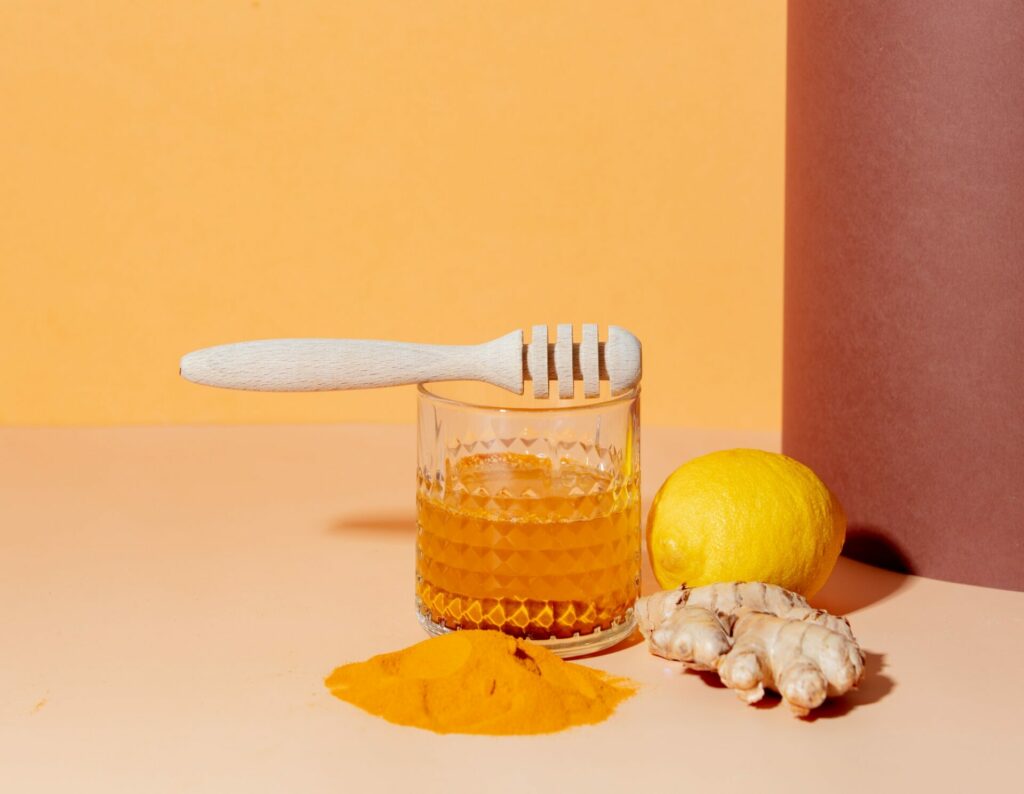
Turmeric, often referred to as the “golden spice,” has been a staple in traditional medicine for centuries. Originating from the curcuma longa plant, turmeric is renowned for its vibrant yellow hue and distinct earthy flavour. While it has long been a kitchen essential, the trend of consuming turmeric in the form of juice has gained popularity in recent years, thanks to its numerous health benefits.
The Power of Curcumin:
At the heart of turmeric’s health-promoting properties lies curcumin, a potent anti-inflammatory and antioxidant compound. Curcumin is responsible for the spice’s distinctive color and is believed to be the primary driver behind its wide-ranging health benefits.
Anti-Inflammatory Properties:
Chronic inflammation is linked to various health issues, including heart disease, cancer, and arthritis. Turmeric juice, with its concentrated curcumin content, has been shown to be an effective natural anti-inflammatory agent. Regular consumption may help reduce inflammation in the body, potentially alleviating symptoms associated with inflammatory conditions.
Antioxidant Boost:
Oxidative stress, caused by an imbalance between free radicals and antioxidants in the body, contributes to aging and various diseases. Turmeric juice, rich in curcumin, acts as a powerful antioxidant, neutralizing free radicals and supporting the body’s defence against oxidative damage. This antioxidant boost may contribute to overall well-being and longevity.
Joint Health:
The anti-inflammatory properties of turmeric make it a popular choice for those seeking relief from joint pain and arthritis. Regular consumption of turmeric juice may help reduce swelling and stiffness, promoting better joint health and flexibility.
Digestive Support:
Turmeric has been traditionally used to aid digestion. The spice stimulates bile production, which helps break down fats in the digestive system. Turmeric juice may be particularly beneficial for individuals with digestive issues, promoting a healthier gut and reducing symptoms such as bloating and indigestion.
Heart Health:
Numerous studies suggest that turmeric may have cardiovascular benefits. It is believed to improve the function of the endothelium, the lining of blood vessels, and reduce the risk of heart disease. By enhancing blood vessel function and reducing inflammation, turmeric juice may contribute to a healthier cardiovascular system.
Brain Health and Cognitive Function:
Emerging research indicates that curcumin may have neuroprotective effects, potentially reducing the risk of neurodegenerative diseases like Alzheimer’s. While more research is needed, incorporating turmeric juice into your diet may be a flavourful way to support brain health and cognitive function.
Turmeric juice recipe
- Ingredients:
1-2 fresh turmeric roots (or 1-2 teaspoons of turmeric powder)
1-2 inches of fresh ginger root
1 lemon (peeled)
1-2 tablespoons of honey or maple syrup (optional, for sweetness)
4 cups of water
Ice cubes (optional)
- Instructions:
- Prepare the Turmeric and Ginger: If using fresh turmeric roots, peel and chop them into smaller pieces. Peel and slice the ginger into smaller chunks.
- Blend Turmeric, Ginger, and Lemon: In a blender, combine the chopped turmeric, ginger, and peeled lemon. Add a small amount of water to facilitate blending. Blend until you achieve a smooth consistency.
- Strain the Mixture: Place a fine mesh strainer or cheesecloth over a bowl or pitcher. Pour the blended mixture through the strainer to separate the juice from the pulp. Use a spoon to press out as much liquid as possible.
- Sweeten (Optional): If you prefer a sweeter taste, add honey or maple syrup to the strained juice. Stir well until the sweetener is fully dissolved.
- Dilute with Water: Pour the strained juice back into the blender. Add the remaining water and blend briefly to ensure even mixing. Adjust the water quantity to achieve your preferred concentration.
- Chill and Serve: Transfer the turmeric juice to a glass pitcher. If desired, add ice cubes to chill the juice. Stir well before serving to ensure a consistent flavour.
- Garnish (Optional): Garnish with a slice of lemon or a sprig of mint for a refreshing touch.
- Enjoy the Golden Elixir: Pour yourself a glass of this golden elixir and savour the refreshing taste and health-boosting benefits of turmeric juice.
Ginger Juice
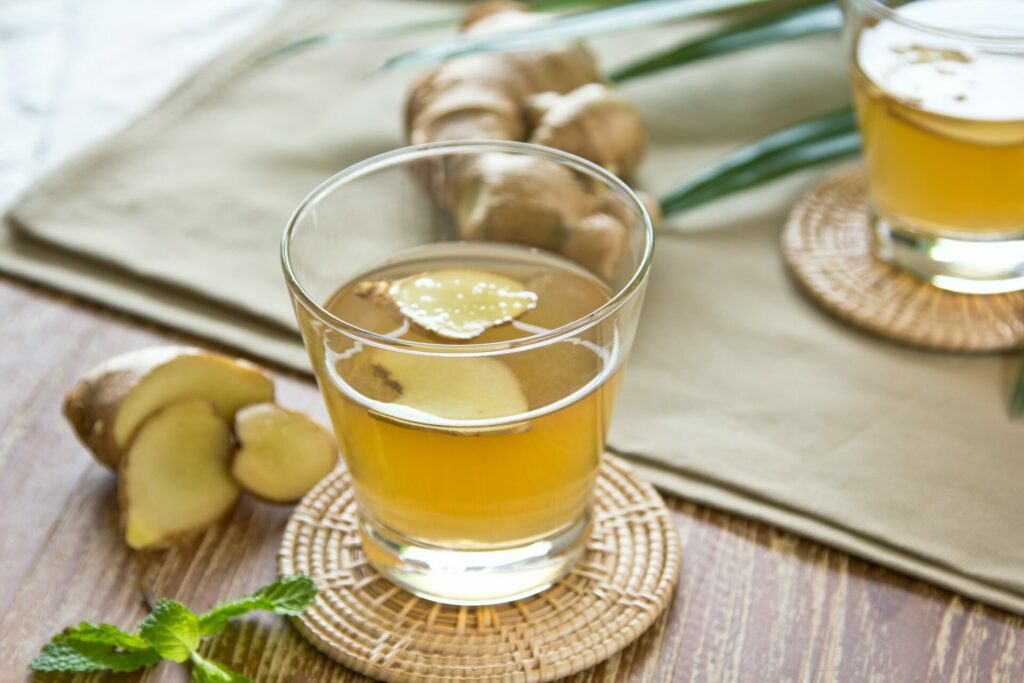
Ginger, a versatile spice revered for centuries, has transcended its culinary role to become a potent health elixir. Among its many forms, ginger juice stands out as a concentrated powerhouse of nutrients and bioactive compounds that contribute to overall well-being.
The Nutritional Profile of Ginger Juice:
Ginger juice is extracted from the rhizome of the ginger plant, known scientifically as Zingiber officinale. This liquid gold is rich in essential nutrients, including vitamins, minerals, and antioxidants. The key components that make ginger juice a nutritional marvel include gingerol, the bioactive compound responsible for its distinctive flavour and therapeutic properties.
Antioxidant Richness:
One of the standout features of ginger juice is its high antioxidant content. Antioxidants play a crucial role in neutralizing free radicals in the body, which are unstable molecules linked to various chronic diseases and aging. Gingerol, the primary bioactive compound in ginger, possesses powerful antioxidant properties, making ginger juice a valuable addition to an anti-inflammatory and anti-aging regimen.
Digestive Harmony:
Ginger has long been celebrated for its digestive benefits, and ginger juice takes this reputation to the next level. The active compounds in ginger, such as gingerol and shogaol, stimulate the production of digestive enzymes, promoting efficient digestion and reducing gastrointestinal discomfort. Individuals suffering from indigestion or nausea often find relief by incorporating ginger juice into their routine.
Immune System Support:
A robust immune system is essential for warding off illnesses, and ginger juice can be a valuable ally in this regard. The anti-inflammatory and antioxidant properties of ginger contribute to immune system modulation, helping the body defend itself against infections. Regular consumption of ginger juice may provide an added layer of defence during cold and flu seasons.
Pain Relief and Anti-Inflammatory Effects:
Ginger’s potent anti-inflammatory properties make it a natural remedy for managing pain and inflammation. Athletes and individuals dealing with chronic conditions like arthritis often turn to ginger juice as a complementary approach to alleviate discomfort. The anti-inflammatory effects of gingerol may help reduce muscle soreness, joint pain, and overall inflammation throughout the body.
Blood Sugar Regulation:
Emerging research suggests that ginger may play a role in regulating blood sugar levels. This is particularly significant for individuals with diabetes or those at risk of developing the condition. Ginger juice, with its concentrated form of beneficial compounds, could be a supportive element in managing blood sugar and improving insulin sensitivity.
Culinary Versatility:
Beyond its health benefits, ginger juice adds a burst of flavour to various culinary creations. Whether used in marinades, dressings, or beverages, the zesty and slightly spicy profile of ginger juice enhances the taste of both sweet and savoury dishes. This culinary versatility makes it easy to incorporate ginger juice into a diverse range of recipes.
Ginger juice recipe
- Ingredients:
Fresh ginger root (about 1 cup, peeled and chopped)
Water (2 cups)
Lemon (optional, for added flavour)
Honey or agave syrup (optional, for sweetness)
- Instructions:
1. Preparation: Begin by washing and peeling the ginger root. Use a spoon to scrape off the thin skin, or you can use a knife for this purpose. Chop the peeled ginger into small, manageable pieces. The smaller the pieces, the easier it will be to extract the juice.
2. Blending: Place the chopped ginger in a blender or food processor. Add 1 cup of water to facilitate the blending process. Blend the ginger until it forms a smooth, pulpy consistency. If necessary, you can add more water to achieve the desired texture.
3. Straining: To separate the juice from the pulp, place a fine mesh strainer or cheesecloth over a bowl or jug. Pour the blended ginger mixture into the strainer, allowing the juice to pass through while retaining the fibrous pulp.
4. Extracting Maximum Juice: To ensure you extract all the juice, use the back of a spoon to press the pulp against the strainer. This will help extract any remaining liquid.
5. Optional Additions: If you desire a hint of citrus, squeeze fresh lemon juice into the ginger juice. This not only adds flavour but also contributes additional health benefits. For those with a sweet tooth, you can add honey or agave syrup to the ginger juice. Adjust the sweetness according to your preference.
6. Storage: Transfer the freshly extracted ginger juice into a clean glass container with a lid. Refrigerate the ginger juice for up to one week. Shake well before use, as natural settling may occur over time.
7. Serving: Ginger juice can be enjoyed in various ways. Mix it with water for a refreshing ginger-infused drink, or add it to your favourite smoothies and cocktails.
Beetroot Juice
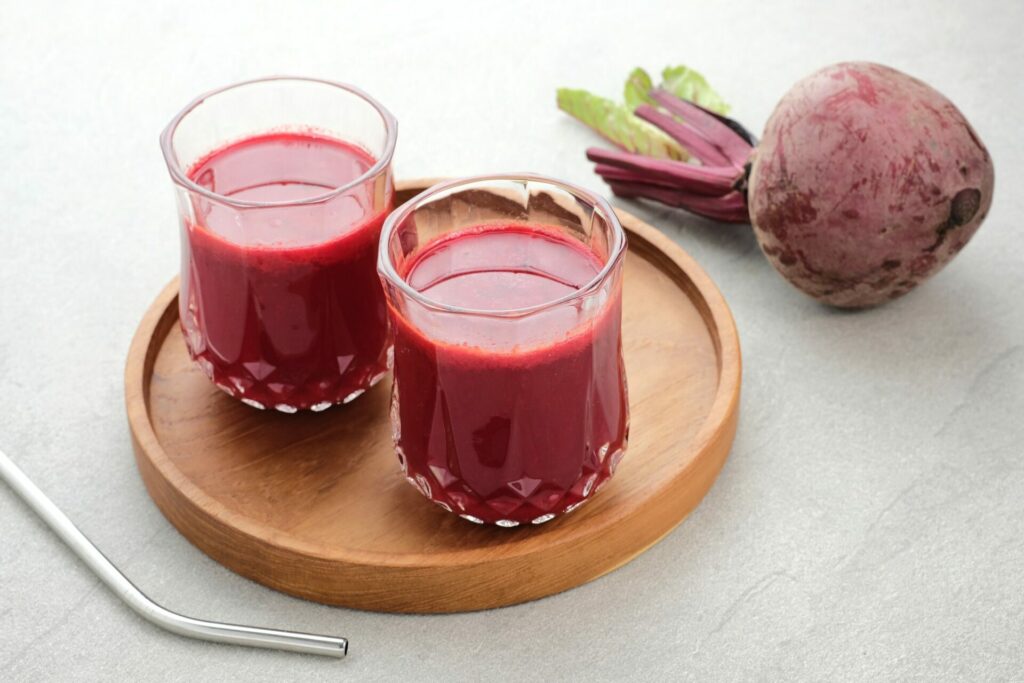
In the realm of wellness and nutrition, the spotlight is increasingly turning towards natural remedies and superfoods. Among the rising stars is the humble beetroot, celebrated not only for its vibrant color but also for the myriad health benefits it brings to the table. At the heart of this nutritional revolution is Beetroot juice, a concoction that harnesses the potent goodness of beetroots, offering a refreshing and health-boosting elixir.
Understanding the Beetroot Renaissance:
Beetroots, commonly known as beets, have been a staple in diets for centuries. However, it is only in recent years that their nutritional prowess has gained widespread recognition. Packed with essential vitamins, minerals, and antioxidants, beetroots have become a focal point for health enthusiasts and nutritionists alike.
The Beetroot Juice Symphony:
Beetroot juice is the concentrated essence of beetroots, extracted through juicing or blending. The process retains the inherent nutritional value while providing a convenient and palatable way to incorporate beetroots into one’s diet. The deep, rich hue of the juice is a visual testament to the concentrated goodness within.
The Nutritional Symphony of Beetroot Juice:
1. Antioxidant Powerhouse:
Beetroots are rich in antioxidants, particularly betalains, which combat oxidative stress and inflammation in the body. Beetroot juice, with its concentrated form, delivers a potent antioxidant punch, supporting overall health and well-being.
2. Blood Pressure Buddy:
One of the standout benefits of Beetroot juice lies in its ability to promote cardiovascular health. The nitrates found in beetroots are converted into nitric oxide, a compound that relaxes blood vessels, leading to lower blood pressure. Regular consumption of Beetroot juice may contribute to maintaining a healthy cardiovascular system.
3. Stamina and Performance Booster:
Athletes and fitness enthusiasts are increasingly turning to Beetroot juice for its potential to enhance exercise performance. The nitrates in beetroots improve oxygen utilization, leading to increased endurance and stamina. Incorporating Beetroot juice into pre-workout routines may offer a natural and effective performance boost.
4. Liver Love:
Beetroots contain compounds that support liver detoxification processes. Beetroot juice acts as a liver tonic, aiding in the elimination of toxins from the body. This makes it a valuable addition to detox regimens and overall liver health maintenance.
5. Nutrient Laden Elixir:
Beetroot juice is a nutrient powerhouse, delivering a concentrated dose of essential vitamins and minerals. From vitamin C, potassium, and folate to iron and manganese, the juice provides a diverse array of nutrients crucial for various bodily functions.
Beetroot Juice Recipe
- Ingredients:
2 medium-sized beetroots, peeled and chopped
1 medium-sized apple, cored and chopped
1 carrot, peeled and chopped
1-inch piece of ginger, peeled
1 lemon, juiced
2 cups cold water
Ice cubes (optional)
Honey or agave syrup for sweetness (optional)
- Instructions:
1. Prepare the Ingredients: Wash, peel, and chop the beetroots, apple, and carrot into small, manageable pieces. Peel and chop the ginger into smaller pieces for easy blending.
2. Blend the Ingredients: In a blender, combine the chopped beetroots, apple, carrot, and ginger. Add the cold water to facilitate blending. Blend on high speed until you achieve a smooth consistency.
3. Strain (Optional): For a smoother juice, you can strain the mixture using a fine mesh sieve or cheesecloth to remove the pulp. If you prefer a heartier juice, you can skip this step.
4. Add Citrus Zing: Squeeze the juice of one lemon into the blended mixture. The citrusy kick not only enhances the flavour but also adds a burst of vitamin C.
5. Sweeten to Taste: If desired, add honey or agave syrup to sweeten the juice. Start with a small amount and adjust according to your preference.
6. Chill and Serve: Refrigerate the BEEROOT juice for at least an hour to enhance its refreshing quality. Serve over ice cubes if you prefer a chilled beverage.
7. Get Creative: Feel free to experiment with additional ingredients to tailor the flavour to your liking. Mint leaves or a splash of orange juice can add an extra layer of freshness.
8. Health Boosting Tip: Consider adding a pinch of black pepper to enhance the absorption of nutrients. The piperine in black pepper can improve the bioavailability of certain compounds in beetroots.
9. Enjoy the Benefits: Sip and savour the vibrant BEEROOT juice, knowing that each gulp is packed with antioxidants, vitamins, and minerals.
Kale Juice
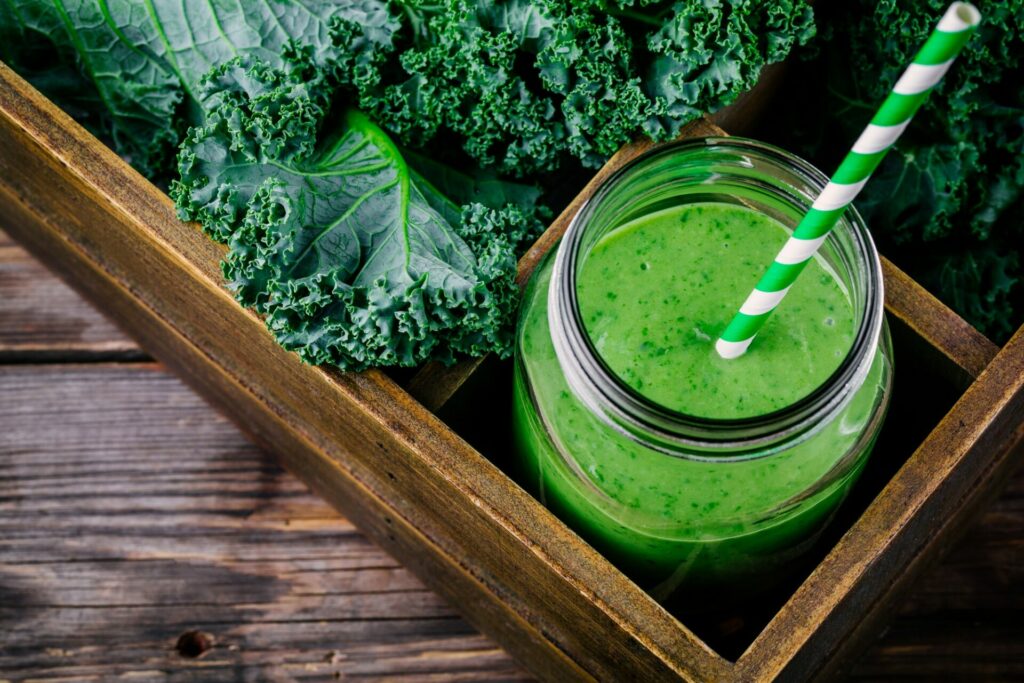
In the world of health and wellness, kale has emerged as a superstar, celebrated for its exceptional nutritional profile and numerous health benefits. One of the most popular ways to harness its powerhouse nutrients is through kale juice, a vibrant green elixir that has gained popularity among health enthusiasts. Let’s delve into the kaleidoscope of benefits that kale juice brings to the table.
Nutrient-Rich Powerhouse:
Kale is a cruciferous vegetable that packs a punch when it comes to essential nutrients. Kale juice is a concentrated source of vitamins A, C, and K, as well as minerals like iron, calcium, and potassium. These nutrients play crucial roles in supporting immune function, bone health, and overall vitality.
Antioxidant Boost:
Kale is renowned for its high antioxidant content, which helps combat oxidative stress in the body. The antioxidants in kale, such as beta-carotene and flavonoids, help neutralize free radicals, reducing the risk of chronic diseases and promoting cellular health. Regular consumption of kale juice provides a potent antioxidant boost for a resilient and vibrant body.
Heart Health:
Studies have suggested that the compounds found in kale may contribute to cardiovascular health. Kale is rich in fibre, which helps lower cholesterol levels, and its antioxidants have been linked to a reduced risk of heart disease. Including kale juice in a heart-healthy diet may contribute to maintaining optimal cardiovascular function.
Detoxification and Weight Management:
Kale is a natural detoxifier, supporting the body’s detoxification processes and promoting a healthy liver. The fibre content in kale also aids in digestion and promotes a feeling of fullness, making it a valuable addition to a weight management plan. Kale juice can be a refreshing and low-calorie option for those looking to support their weight loss journey.
Skin Radiance:
The combination of vitamins and antioxidants in kale contributes to skin health. Vitamin C, in particular, promotes collagen production, helping maintain skin elasticity and reducing the appearance of wrinkles. Regular consumption of kale juice may contribute to a radiant complexion and overall skin well-being.
Blood Sugar Regulation:
Some studies suggest that kale may play a role in regulating blood sugar levels. The fibre and antioxidants in kale may contribute to improved insulin sensitivity, making it a beneficial choice for individuals managing diabetes or those looking to prevent blood sugar spikes.
Anti-Inflammatory Properties:
Chronic inflammation is linked to various health conditions, including arthritis and heart disease. Kale contains anti-inflammatory compounds, such as quercetin and kaempferol, which may help reduce inflammation in the body. Including kale juice in a balanced diet can contribute to an anti-inflammatory lifestyle.
Kale juice recipe
- Ingredients:
2 cups fresh kale leaves, washed and chopped
1 cucumber, peeled and sliced
2 green apples, cored and chopped
1 lemon, peeled and segmented
1-inch piece of fresh ginger, peeled
1-2 stalks of celery, chopped
1-2 cups cold water or coconut water (adjust for desired consistency)
Ice cubes (optional)
- Instructions:
- Prepare the Ingredients: Wash the kale leaves thoroughly, and remove the tough stems. Peel and chop the cucumber. Core and chop the green apples. Peel and segment the lemon. Peel the ginger.
- Juicing Process: Place the kale, cucumber, green apples, lemon segments, ginger, and celery into a juicer. Start the juicer and process the ingredients until you get a smooth juice. If your juicer has different speed settings, use a lower speed for leafy greens like kale.
- Adjust Consistency: Depending on your preference, you can adjust the consistency of the juice by adding cold water or coconut water. This also helps mellow out the flavours.
- Strain (Optional): If you prefer a smoother juice, you can strain the mixture using a fine mesh sieve or cheesecloth to remove pulp. However, keeping the pulp adds extra fibre to your juice.
- Serve and Enjoy: Pour the kale juice into glasses over ice cubes if desired. Garnish with a slice of lemon or a few cucumber slices for a decorative touch.
Cucumber Juice
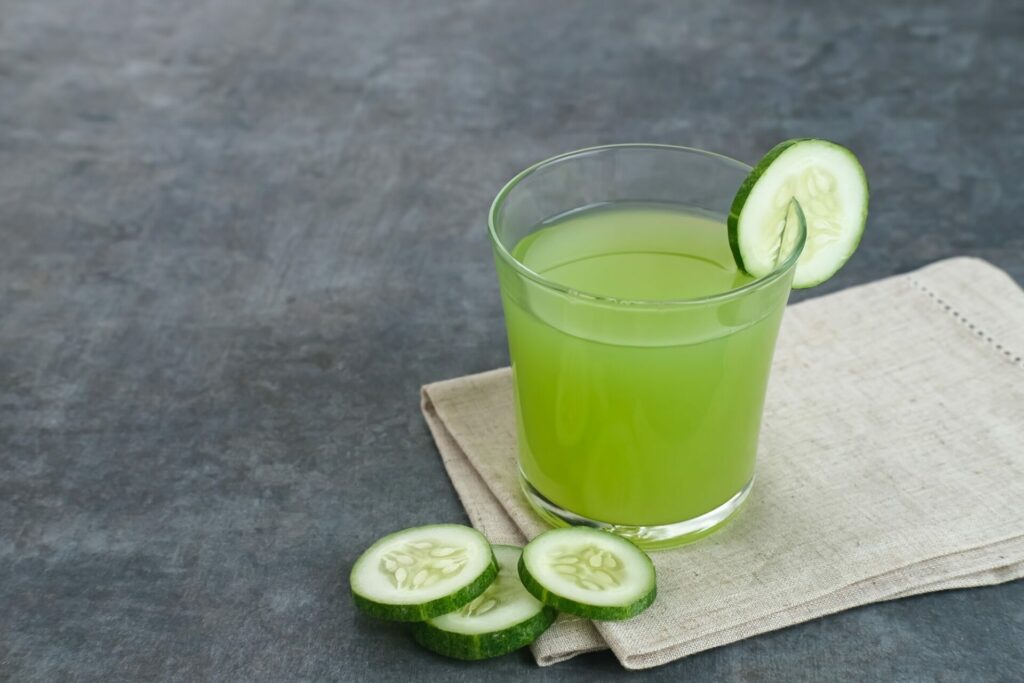
In the world of wellness, the spotlight is often on superfoods and trendy beverages that promise a myriad of health benefits. Amidst the kale smoothies and acai bowls, one humble yet extraordinary drink has been gaining attention for its refreshing taste and numerous health advantages – cucumber juice.
The Green Elixir: Nutritional Powerhouse
Cucumber juice, derived from the unassuming cucumber, is a simple and delicious way to boost your overall health. Cucumbers are composed of over 95% water, making them an excellent hydrating agent. This high water content, coupled with essential vitamins and minerals, positions cucumber juice as a nutritional powerhouse.
One of the primary benefits of cucumber juice is its ability to promote hydration. Staying adequately hydrated is crucial for various bodily functions, including digestion, nutrient absorption, and temperature regulation. Cucumber juice, with its water-rich composition, not only quenches thirst but also provides the body with essential electrolytes.
Rich in Antioxidants: A Defence against Free Radicals
Antioxidants play a pivotal role in protecting the body against oxidative stress caused by free radicals. Cucumber juice is a rich source of antioxidants, such as beta-carotene, flavonoids, and tannins. These compounds help neutralize free radicals, reducing the risk of chronic diseases and promoting overall well-being.
Regular consumption of cucumber juice has been linked to improved skin health. The antioxidants present in the juice contribute to a youthful complexion by combating the effects of environmental pollutants and UV radiation. Additionally, cucumber juice contains silica, a compound known for its role in promoting collagen production, thereby enhancing skin elasticity.
Digestive Aid: Soothing the Stomach
Cucumber juice is renowned for its digestive benefits. The high water and fibre content of cucumbers contribute to improved digestion and bowel regularity. The juice acts as a mild diuretic, aiding in the elimination of toxins from the body. It is also known to soothe an irritated stomach and alleviate symptoms of acid reflux.
For those struggling with weight management, cucumber juice can be a valuable addition to a balanced diet. Low in calories and high in water content, it provides a satisfying and hydrating option for those looking to curb their calorie intake without sacrificing flavour.
Blood Sugar Regulation: A Boon for Diabetics
Recent research has suggested that cucumber juice may play a role in regulating blood sugar levels. The presence of bioactive compounds, including cucurbitacins, in cucumbers may contribute to improved insulin sensitivity. While more research is needed in this area, initial findings suggest that cucumber juice could be a valuable component of a diabetes-friendly diet.
Cucumber Juice recipe
- Ingredients:
2 large cucumbers (organic, if possible)
1/2 cup fresh mint leaves
1 tablespoon honey or agave syrup (optional, for sweetness)
1 tablespoon freshly squeezed lemon juice
2 cups cold water
Ice cubes (optional)
- Instructions:
1. Prepare the Cucumbers: Wash the cucumbers thoroughly, and if they are not organic, consider peeling them to remove any pesticide residue. Cut the cucumbers into chunks that fit easily into your blender.
2. Blend Cucumbers and Mint: In a blender, combine the cucumber chunks and fresh mint leaves. Add the cold water to the blender to aid in the blending process. Blend on high speed until the mixture is smooth and well combined.
3. Strain the Mixture: To achieve a smoother juice, strain the cucumber and mint blend using a fine mesh sieve or cheesecloth. Press down with a spoon to extract as much liquid as possible. Discard the remaining pulp or save it for other recipes like smoothies or face masks.
4. Sweeten and Add Citrus: Taste the cucumber-mint juice and add honey or agave syrup if you prefer a sweeter flavour. Blend again to combine. Squeeze fresh lemon juice into the mixture for a citrusy zing. Adjust the sweetness and acidity according to your taste.
5. Chill and Serve: Refrigerate the cucumber mint juice for at least 30 minutes before serving. Serve over ice cubes for an extra refreshing experience.
6. Garnish (Optional): Garnish the cucumber mint juice with a few fresh mint leaves or cucumber slices for a decorative touch.
7. Enjoy!: Pour the chilled cucumber mint juice into glasses and savour the revitalizing taste. This beverage is perfect for hot summer days or as a hydrating pick-me-up at any time.
Also read Top 15 Easy to Make Mocktail Recipes
Carrot Juice
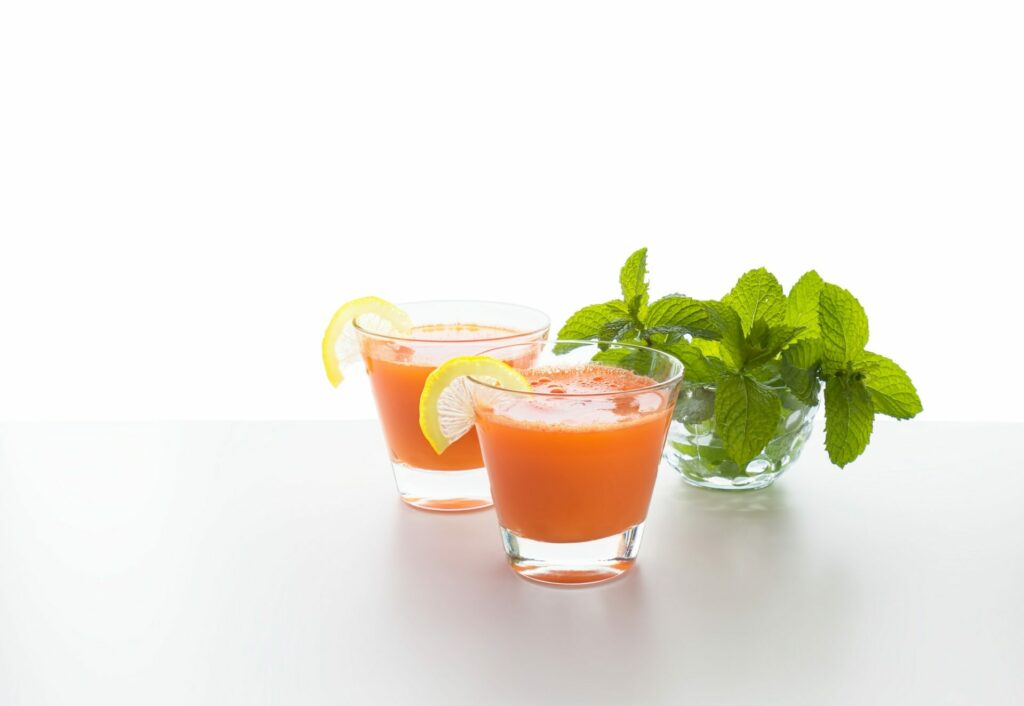
In the realm of nutritional powerhouses, carrot juice stands out as a vibrant elixir, boasting a myriad of health benefits that go beyond its delightful taste and eye-catching hue. Packed with essential nutrients, this liquid gold has become a popular choice among health enthusiasts and nutritionists alike.
Nutrient-Rich Composition:
Carrot juice is a treasure trove of essential nutrients, most notably beta-carotene, which is converted into vitamin A in the body. Vitamin A plays a pivotal role in maintaining healthy vision, skin, and a robust immune system. Additionally, carrot juice is a good source of vitamins C, K, and B complex, along with minerals like potassium and manganese. These nutrients collectively contribute to the optimal functioning of various bodily systems.
Visionary Health:
One of the standout benefits of carrot juice lies in its ability to promote eye health. The high concentration of beta-carotene, an antioxidant that gives carrots their vibrant orange color, is crucial for maintaining healthy vision. Adequate intake of beta-carotene has been linked to a reduced risk of age-related macular degeneration, a common cause of vision impairment and blindness in older adults.
Immune System Support:
Carrot juice acts as a natural booster for the immune system, thanks to its rich content of vitamins and antioxidants. Vitamin C, in particular, plays a key role in enhancing the immune response, helping the body fend off infections and illnesses. Regular consumption of carrot juice can contribute to a resilient immune system, keeping you better equipped to face the challenges of daily life.
Radiant Skin:
The benefits of carrot juice extend to the realm of skincare. The antioxidants and vitamins present in carrot juice contribute to a healthy complexion by combating free radicals and promoting cell regeneration. Regular consumption can help reduce signs of aging, leaving your skin looking radiant and rejuvenated.
Heart Health:
Incorporating carrot juice into your diet can contribute to a heart-healthy lifestyle. The potassium content in carrots helps regulate blood pressure, reducing the risk of cardiovascular diseases. Furthermore, the soluble fibre in carrot juice has been associated with lower cholesterol levels, promoting better heart health and reducing the risk of heart-related ailments.
Weight Management:
For those on a weight management journey, carrot juice can be a valuable ally. Low in calories and high in fibre, it provides a satisfying beverage option that helps control hunger and cravings. The natural sweetness of carrot juice can also be a healthier alternative to sugary drinks, supporting overall weight maintenance.
Detoxification and Digestive Health:
Carrot juice acts as a natural detoxifier, aiding the body in eliminating toxins and promoting a healthy digestive system. The fibre content helps regulate bowel movements and prevent constipation. The antioxidants in carrot juice contribute to liver health, supporting the body’s natural detoxification processes.
Carrot Juice recipe
- Ingredients:
4-5 large carrots, washed and peeled
1-2 apples, cored and sliced
1-inch piece of ginger, peeled
1 lemon, juiced
Optional: a pinch of turmeric or a small bunch of fresh mint for added flavour
- Instructions:
- Preparation: Wash and peel the carrots, ensuring they are free from dirt and debris. Core and slice the apples. Peel the ginger.
2.Juicing: Cut the carrots into smaller pieces to fit into your juicer chute.
3.Add the carrot pieces, apple slices, and peeled ginger to the juicer. Juice the ingredients, collecting the vibrant liquid in a pitcher.
4. Finishing Touch: Squeeze the juice of one lemon into the pitcher for a citrusy zing. Adjust the amount according to your taste preference.
5. Mixing: Stir the juice well to ensure all flavours are blended evenly.
6. Straining (Optional): If you prefer a smoother juice, you can strain it through a fine mesh sieve or cheesecloth to remove any pulp.
7. Chill and Serve: Refrigerate the carrot juice for a few hours to enhance its refreshing quality. Serve the chilled carrot juice in glasses over ice, garnished with a slice of lemon or a sprig of mint if desired.
Pineapple Juice

Pineapple juice, extracted from the succulent and tropical pineapple fruit, is not only a refreshing beverage but also a powerhouse of nutrients with numerous health benefits. Bursting with vitamins, enzymes, and antioxidants, this golden elixir has become a popular choice for those seeking a delicious way to boost their well-being.
Nutritional Profile:
Pineapple juice is rich in essential vitamins and minerals, making it a nutrient-dense addition to your diet. A single cup of pineapple juice provides a significant dose of vitamin C, an antioxidant crucial for immune system support, skin health, and collagen production. Additionally, it contains vitamin A, vitamin B6, thiamine, and folate, contributing to overall health and vitality.
Digestive Aid:
Pineapple juice is renowned for its natural enzymes, bromelain being the most prominent. Bromelain aids in the digestion of proteins, helping to break them down into smaller, more manageable components. This digestive enzyme not only promotes a healthier digestive system but may also alleviate digestive issues such as bloating and indigestion.
Anti-Inflammatory Properties:
The bromelain found in pineapple juice also exhibits powerful anti-inflammatory properties. Inflammation is linked to various chronic diseases, and consuming pineapple juice may help reduce inflammation and alleviate symptoms associated with conditions like arthritis and sinusitis. Regular intake of pineapple juice may contribute to an overall reduction in inflammation throughout the body.
Immune System Boost:
Pineapple juice’s high vitamin C content is a crucial factor in supporting a robust immune system. Vitamin C stimulates the production of white blood cells, enhances the body’s ability to fight off infections, and acts as a potent antioxidant, neutralizing free radicals that can damage cells. Including pineapple juice in your diet during cold and flu seasons may help fortify your body’s defences.
Hydration and Electrolyte Balance:
Staying hydrated is essential for overall health, and pineapple juice can be a flavourful way to meet your fluid needs. Additionally, it contains essential electrolytes like potassium, which plays a crucial role in maintaining proper fluid balance, muscle contractions, and nerve signals. Incorporating pineapple juice into your hydration routine can be especially beneficial after intense physical activity.
Heart Health:
The combination of antioxidants, fibre, and potassium in pineapple juice contributes to heart health. Antioxidants help reduce oxidative stress, while fibre helps lower cholesterol levels. Potassium, on the other hand, supports healthy blood pressure levels by counteracting the effects of sodium. Regular consumption of pineapple juice, as part of a balanced diet, may contribute to cardiovascular well-being.
Weight Management:
Pineapple juice can be a flavourful and low-calorie addition to your diet, making it a smart choice for those looking to manage their weight. The natural sweetness of pineapple juice satisfies sweet cravings without the added sugars found in many processed beverages, making it a healthier alternative.
Pineapple Juice recipe
- Ingredients:
1 whole pineapple
1-2 tablespoons honey or agave syrup (optional, depending on sweetness preference)
1-2 teaspoons freshly squeezed lemon or lime juice (optional, for added brightness)
Ice cubes (optional)
- Instructions:
- Selecting and Preparing the Pineapple: Choose a ripe pineapple with a sweet aroma and golden color. Wash the pineapple thoroughly. Cut off the crown and the base of the pineapple. Stand the pineapple upright and slice off the outer skin, ensuring to remove any “eyes.”
- Removing the Core: Cut the pineapple into rings or chunks. To remove the core, make a small, V-shaped cut on each slice to eliminate the tougher centre part.
- Blending: Place the pineapple chunks or rings in a blender. Blend on high until the pineapple becomes a smooth puree.
- Straining (Optional): For a smoother juice, strain the puree using a fine mesh sieve, cheesecloth, or a nut milk bag. Press down to extract as much liquid as possible.
- Sweetening (Optional): Taste the juice and decide if you want to add sweetness. If needed, incorporate honey or agave syrup, blending again to combine.
- Adjusting Acidity (Optional): If you prefer a tangier flavour, add freshly squeezed lemon or lime juice. Blend again to incorporate.
- Chilling: Transfer the juice to a pitcher and refrigerate for at least an hour before serving. Alternatively, you can serve it over ice.
- Serve and Enjoy: Pour the chilled pineapple juice into glasses and savour the tropical goodness.
In this journey through the top 10 healing juices of 2024, we have uncovered the science behind their benefits, from anti-inflammatory and antioxidant properties to immune support and digestive harmony. As the world embraces the natural healing power of these juices, incorporating them into a balanced lifestyle may pave the way for a healthier, more vibrant future. Cheers to a juicier and healthier you in 2024!



